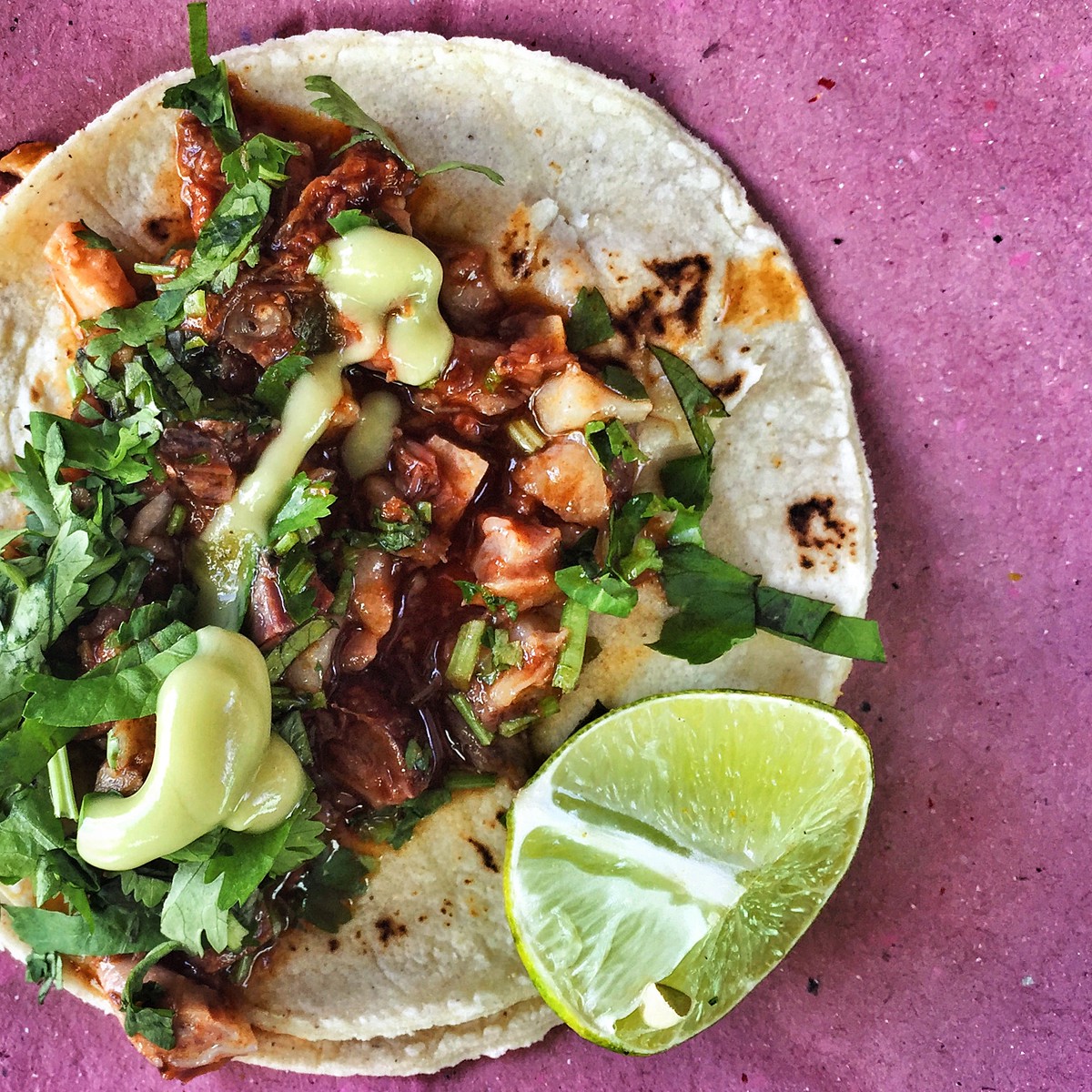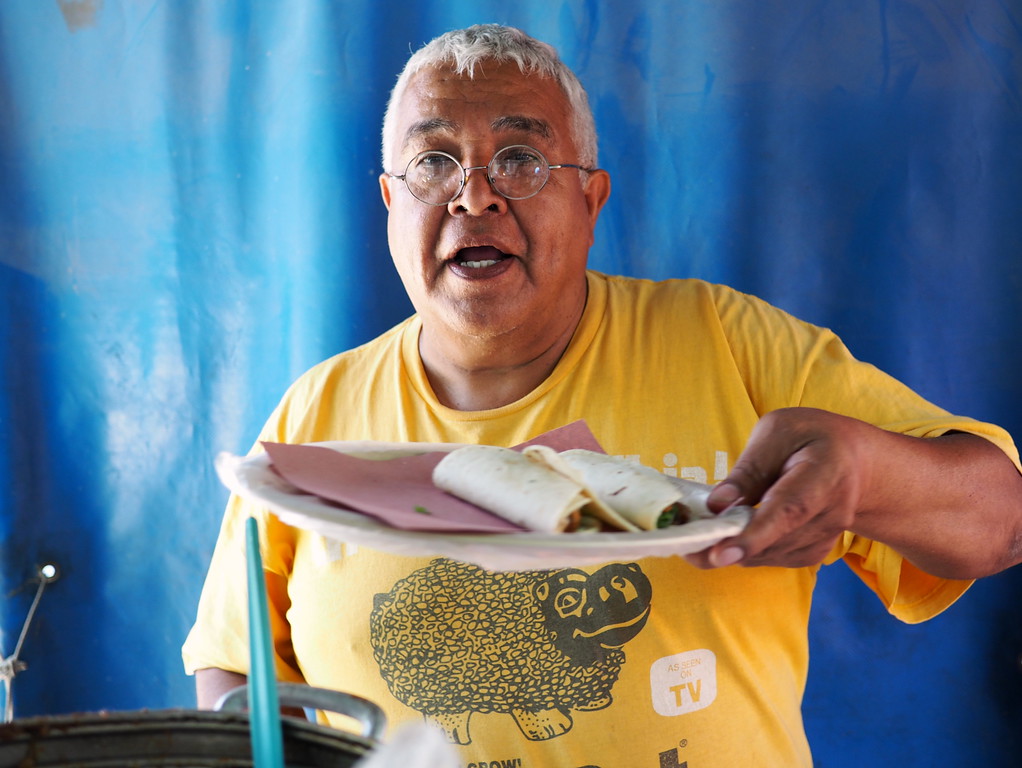Sponsored Listings:
It’s Wednesday and I realize with a start that I’m late again. I have a conference call in a few minutes, and I’m wandering deep in thought on the other side of town. More importantly, I completely forgot to eat. For a woman who writes about food for a living, this oversight is a counterintuitive but consistent affliction. Everything is blotted out when I am deep in a writing project or speech. Yes, even food. I walk around in a daze thinking wordy thoughts.
Israel’s taco restaurant consists of a tiny mobile stand with two stools facing a makeshift bar, propped up against the wheels. In addition to his metal pot, divided into quarters to separate the types of meat and the tortillas, he has a cooler filled with drinks and sauces. When he’s not parked, you wouldn’t know he was coming. The don’t call it tacos ambulantes (wandering tacos) for nothing.
As I half lean on a stool, blood sugar crashing, I catch an older man smiling at me from the corner of my eye. “Where are you from? And are you married?” he asks. “And where is your family? Are they here?” I open my mouth to try to answer his stream of questions but Israel cuts me off with a smile.
“Tranquilo,” he interjects. “Let her eat first.”
I wolf down the first of my tacos as both men eye me warily, perhaps wondering if I can breathe while eating that quickly. Once I wipe off the salsa with a paper napkin, I turn to the other diner and answer his questions.
Israel presides over our talk like a proud papa, looking from one of us to the other.
“Isn’t life grand?” he asks no one and everyone. We smile, then dip our heads to take another bite of our tacos.
Tacos de cabeza, surtidos style.
A Little About Those Cow Head Tacos
Much like dumplings in Asia, many different meats and cuts go into tacos in Mexico. In his book Planet Taco, Jeffrey Pilcher notes:
“People have been eating corn tortillas with bits of meat or beans rolled up inside of them for more than a millenium, but the taco achieved national hegemony only in the twentieth century. Traditionally, every region in Mexico had its own distinctive snack foods, collectively known as antojitos (little whimsies), formed in countless ingenious shapes and given a wide variety of local names.”
The now ubiquitous taco is a more modern usage for one of those antojitos. In the 1831 book El Cocinero Mexicano, a list of corn snacks like quesadillas and chilaquiles, also did not mention tacos. Per Pilcher, tacos-as-descriptor only became popular following the publication of Los banditos de Rio Frio (The Bandits of the Cold River) in 1891, which makes reference to children “skipping, with tacos of tortillas and avocado in their hand.” Though the expression was obviously used prior to publication, it was with this new book that it “quickly received official recognition,” says Pilcher, with attribution officially given to Mexico City.
In the case of cow head tacos a new world fusion: both beef and pork were Spanish imports. Jose Iturriaga notes in Las Cocinas de Mexico that cow head tacos originate from Bajio, in central Mexico. These days, they are quite popular there, in Sonora, and in the capital of Mexico City. But they’re also found elsewhere in Mexico, cooked with whatever local ingredients fit the bill.
For cow or pork head tacos, this means all of the parts of the head. When ordering, meats are usually split into maciza, which translates into “solid” meat, and can be anything from cheek, to lips, mouth, or neck of the cow. The second grouping is the offal, including eye, tongue, brains, sweetbreads, or machitos (beef intestines). I’m partial to both the maciza and the lengua, tongue tacos. A catch-all for a first foray into tacos de cabeza is surtido, a medley of meats mixed together.
Head meat tacos may sound extreme but they are gourmet-tasting cuts of meat. The tacos are richly textured, tender, and extraordinarily flavourful without being oily. Regardless of style, head tacos usually involve steaming the head overnight, then shredding the meat and adding it back to the pot in its own juice (called consommé).
Of course this is Mexico, so the beef isn’t simply steamed in a flavorless vat. Israel’s steamer includes achiote (annatto), avocado leaves, peppercorns, a variety of different chiles, bay leaves, and some other secret ingredients that he steadfastly keeps to himself. Once ordered, Israel dips into his giant metal steamer and doles out the beef tortillas, which he serves with cilantro, raw onions, a dollop of avocado paste, spicy salsa, and a lime wedge.

The finished product.
My Favourite Taco Philosopher in Oaxaca
When I first got to Oaxaca, I wandered the streets in wonder. After so many years in Asia, curiosity dictated that I eat at every single taco and quesadilla stand I could find that met my rules of eating street food safely. It is during this wander that I stumbled onto Israel’s stall. Originally from Puebla, he has lived in Oaxaca for 15 years, including part of his schooling. He studied both accounting and law — another Thrillable Hours contender? — and worked in accounting for several years following his graduation.
Why did this accountant start making tacos? In 2006, Oaxaca was engulfed in protests, and his entire office was temporarily suspended from work. Needing to feed his family, Israel learned how to make tacos and sell them in a wandering cart. He didn’t sell head tacos in those days. Instead, he focused on what he called “tacos de canasta ambulantes,” greasy chorizo and chicharrones tacos sold out of a basket. These are fried, rolled tacos that he made ahead of time and roamed the streets, selling to protesters who were camped out in the main square and elsewhere.
To his surprise, he made more as a taco vendor than as an accountant. So when the protests cleared and the situation in the city stabilized, he decided to keep selling tacos instead. “No way was I going back to an office,” he says, head thrown back with laughter. He pauses, thoughtful. “But I had to change my tacos.”
It is this thoughtful pondering that makes Israel such a delight. When people come to his cart, he engages in small talk but often they come to him for advice and questions about their choices in life. In the case of his tacos, he switched to steamed head tacos, Sonora-style, because while slightly more expensive they are quite a bit healthier. “It just seemed wrong to make greasy tacos when I could make healthy tacos,” he adds with a shrug.
That’s just the kind of guy he is.

Tacos incoming! <3
I’m still eating tacos and chatting with my fellow diner on that rushed Wednesday when a woman comes running out of a building next to Israel’s cart. Impatient, she calls his name several times before he realizes that during tacos he missed his them calling his number at the government building next door. He scurries off quickly.
Israel turns to me with a sheepish grin and shrugs as if to say, “what can you do? There are tacos to be eaten.” I realize that I, too, ate my tacos and completely forgot about my own obligations.
I wolf down my head tacos, give Israel a quick hug, and rush home for my conference call.
A few days later, my stomach is in the mood for more tacos surtidos and I wander down to Israel’s stall. “Yeni!” he calls out from afar “I see you!”.
Giggling, I push myself onto one of his high stools and order some tacos. A man looking to be in his mid-40s stops in, eyeing me with curiosity. He gives Israel a shrug and slides onto one of the plastic stools in front of the cart.
“Isn’t life grand?” Israel says.
“I am pretty angry today,” the new arrival admits. He glances over at me quickly, unsure if I understand Spanish.
“Oh that’s Yeni,” Israel quickly interjects. “She lives here too.”
The man nods slowly.
“Well,” Isreal continues. “Life is great when your heart is calm. Otherwise life is not great.”
We eat our tacos in silence, thinking about Israel’s words. Almost every time I’ve found him on the streets of Oaxaca, his clients have come by with their life’s troubles, waiting for a word from this head taco philosopher that will put it all in perspective.
We finish our tacos together and Israel takes the other customer’s money first, looking him in the eye. “Remember. You will be in trouble because anger will corrupt your view of the world. The good things in life will become reasons to be angry too. You need to be calm and happy in your heart. The rest will follow.”
The man leaves and Israel turns my way, face cracking into a huge smile.
“You too, Yeni! Don’t worry, though, with tacos in your stomach, it is much easier to be calm and happy in your heart.”

Israel, holding chia water and wearing a ch-ch-ch-Chia shirt — having no idea that it was an ad in North America. Oaxaca grows a lot of chia seeds, and they’re used in lemon water, chocolate, and more.
Part of my joy in getting to know my new home of Oaxaca has been to learn the stories of the people behind the foods I love. I hope you enjoyed this bit about Israel!
More to come soon.
-Jodi
The post The Cow Head Taco Philosopher King of Oaxaca appeared first on Legal Nomads.
Source: legalnomads.com










